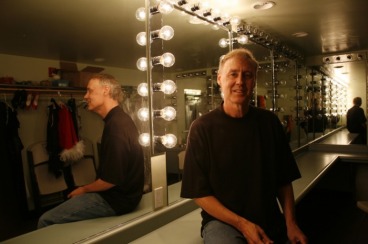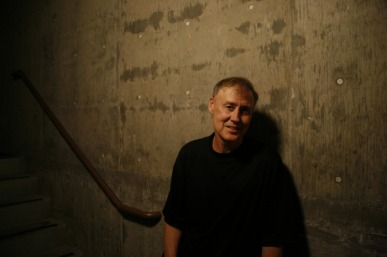"A Dynamo For All Seasons"
Published in Berkshire Eagle (10/5/09)

Photo by Megan Holmes
By Jeremy D. Goodwin
GREAT BARRINGTON—He’s written hits for Don Henley and Huey Lewis, a film soundtrack for Spike Lee, and for two years was a member of the Grateful Dead.
Bruce Hornsby’s musical resume spans three decades—and, it feels like, twice as many lives.
“If you put on my new record and put on the first record, for someone who didn’t know anything about it, I don’t think they would think it was the same person at all,” Hornsby says, in a telephone interview from an Albany hotel.
He’s got a point.
Hornsby came to prominence in the late-80’s, winning a Grammy for Best New Artist in 1987 with backing band The Range. (He later netted Grammys for Best Bluegrass Recording and Best Pop Instrumental). He spent three records compiling a heady list of pop gems before ditching his band, collaborating with a Who’s Who of the music world, and pursuing a looser, jazzier direction in his solo work. Two years ago, he released both a jazz album and a bluegrass album, each recorded with greats of the respective genres. Now he’s working on a musical.
This un-definable dynamo plays the Mahaiwe Performing Arts Center, with band The Noisemakers in tow, on Tuesday. The Wood Brothers open.
Hornsby’s recently released record, “Levitate,” harkens back to the literate, liberated pop of his mid-90’s work, but is deliberately lacking in the dazzling solos that have become his stock in trade.
“The last two records I made were really about playing the instrument well. Bluegrass and jazz are both about virtuosity on the instrument,” he explains. “Every record I’ve made had a good bit of soloing on them, a lot of blowing. I thought I’ve just done this enough, and I don’t feel the need or the interest in doing it again.”
Instead, he intended “Levitate” to showcase his songwriting.
Hornsby cites two new songs—“Paperboy” and “Michael Raphael”—as evidence of his long-held interest in modern classical music. Then he sings a few bars of the somewhat jagged melody of the latter.
“It’s not the people’s sing-along,” he says with a laugh. “I’ve just always had an interest and a love for that extended harmonic and melodic language, and now I’m gradually inflicting it on my poor, unsuspecting audiences.”
Not that a musician with as finely honed a pop sensibility as Hornsby would make his work purposely inaccessible. Noting its “fairly standard, old-style pop” chorus, he describes “Paperboy” as “Schoenberg meets the Beatles.”
Hornsby’s indelible piano riffs anchor Henley’s smash hit “The End of the Innocence,” which the two wrote together, as well as his own “The Way It Is,” the most-played radio hit of 1986. Yet when it came time to release a “greatest hits” collection, Hornsby complied, but buried an implicit complaint in the record’s title: “Greatest Radio Hits.”
“I put this out because they wanted a greatest hits record, but for our true fans the real hits are not those at all,” he says. “For instance, we never play ‘Every Little Kiss.’ It doesn’t resonate with me. It doesn’t hold up with me through the ages. So I don’t play it much and it doesn’t seem to really matter.”
He ticks off a list of early hits he still enjoys, like “Mandolin Rain,” “The Valley Road,” and “The Way It Is.” But though he appreciates the compositions, and enjoys re-inventing these songs in concert, he still doesn’t touch the original recordings.
“It’s un-listenable to me for lots of reasons. Mostly because of the singing. I think it’s pretty bad, it’s just not expressive and not loose…. The songs still really hold up, but there’s been a great improvement through the years on lots of levels.”
GREAT BARRINGTON—He’s written hits for Don Henley and Huey Lewis, a film soundtrack for Spike Lee, and for two years was a member of the Grateful Dead.
Bruce Hornsby’s musical resume spans three decades—and, it feels like, twice as many lives.
“If you put on my new record and put on the first record, for someone who didn’t know anything about it, I don’t think they would think it was the same person at all,” Hornsby says, in a telephone interview from an Albany hotel.
He’s got a point.
Hornsby came to prominence in the late-80’s, winning a Grammy for Best New Artist in 1987 with backing band The Range. (He later netted Grammys for Best Bluegrass Recording and Best Pop Instrumental). He spent three records compiling a heady list of pop gems before ditching his band, collaborating with a Who’s Who of the music world, and pursuing a looser, jazzier direction in his solo work. Two years ago, he released both a jazz album and a bluegrass album, each recorded with greats of the respective genres. Now he’s working on a musical.
This un-definable dynamo plays the Mahaiwe Performing Arts Center, with band The Noisemakers in tow, on Tuesday. The Wood Brothers open.
Hornsby’s recently released record, “Levitate,” harkens back to the literate, liberated pop of his mid-90’s work, but is deliberately lacking in the dazzling solos that have become his stock in trade.
“The last two records I made were really about playing the instrument well. Bluegrass and jazz are both about virtuosity on the instrument,” he explains. “Every record I’ve made had a good bit of soloing on them, a lot of blowing. I thought I’ve just done this enough, and I don’t feel the need or the interest in doing it again.”
Instead, he intended “Levitate” to showcase his songwriting.
Hornsby cites two new songs—“Paperboy” and “Michael Raphael”—as evidence of his long-held interest in modern classical music. Then he sings a few bars of the somewhat jagged melody of the latter.
“It’s not the people’s sing-along,” he says with a laugh. “I’ve just always had an interest and a love for that extended harmonic and melodic language, and now I’m gradually inflicting it on my poor, unsuspecting audiences.”
Not that a musician with as finely honed a pop sensibility as Hornsby would make his work purposely inaccessible. Noting its “fairly standard, old-style pop” chorus, he describes “Paperboy” as “Schoenberg meets the Beatles.”
Hornsby’s indelible piano riffs anchor Henley’s smash hit “The End of the Innocence,” which the two wrote together, as well as his own “The Way It Is,” the most-played radio hit of 1986. Yet when it came time to release a “greatest hits” collection, Hornsby complied, but buried an implicit complaint in the record’s title: “Greatest Radio Hits.”
“I put this out because they wanted a greatest hits record, but for our true fans the real hits are not those at all,” he says. “For instance, we never play ‘Every Little Kiss.’ It doesn’t resonate with me. It doesn’t hold up with me through the ages. So I don’t play it much and it doesn’t seem to really matter.”
He ticks off a list of early hits he still enjoys, like “Mandolin Rain,” “The Valley Road,” and “The Way It Is.” But though he appreciates the compositions, and enjoys re-inventing these songs in concert, he still doesn’t touch the original recordings.
“It’s un-listenable to me for lots of reasons. Mostly because of the singing. I think it’s pretty bad, it’s just not expressive and not loose…. The songs still really hold up, but there’s been a great improvement through the years on lots of levels.”

Photo by Megan Holmes
There was a decidedly subversive element to even his glossiest hits, which were spiked with observations about racial intolerance and Reagan-era spiritual malaise, plus some unexpectedly complex musical touches.
After the huge success he achieved with The Range, Hornsby found a place as the most in-demand collaborator in the business, recruited to play on records with Bob Dylan, Robbie Robertson, Bonnie Raitt, Branford Marsalis, Leon Russell… even jazz piano legend Bill Evans. And he took advantage of his expanded Rolodex to host guests like Phil Collins, Pat Metheny, and Eric Clapton on his own recordings.
Then came perhaps the most unexpected credit: after the death of their keyboardist, Brent Mydland, the Grateful Dead called on Hornsby to perform with them full time for a span between 1990 and 1992. (One of the standout tunes on the new record, “Cyclone,” was co-written with legendary Grateful Dead lyricist Robert Hunter.)
“I just kept getting all of these great calls. It took me into new worlds,” Hornsby recalls. “It was educational and inspirational for me to step into the other people’s worlds and see their process. It just flooded me with new ideas and inspirations. So my music just branched out because of all that. “
His own live shows became looser, filled with improvisation and unexpected segues. He stopped preparing a set list, instead inviting fans to write down requests and leave them onstage. (He estimates that 70% of a show is composed by requests, with the rest of the songs filled out by the handful of new tunes he’s looking to play at a given time.)
Though the twists and turns of his evolving career could hardly be predicted, Hornsby is now providing a bit of a formalized path toward his own brand of polyglot musical awareness. He’s developed the Creative American Music Program, a course of study at the University of Miami.
“I wanted to create a program where you can study Robert Johnson, and Sony Boy Williamson, and Sacred Harp music, and Bill Monroe, and Stephen Foster, and the gospel tradition, and on and on, in the halls of academia."
For a guy who once adorned the cover of an album (“Hot House,” 1995) with an illustration of an imagined jam session between bebop legend Charlie Parker and bluegrass pioneer Monroe, it makes perfect sense.
“I’m a lifelong music student,” Hornsby says. “I just think that if you have a broad range of knowledge it can only help your music be broad in its scope. That’s what I’ve always been interested in.”
Indeed.
______________________
